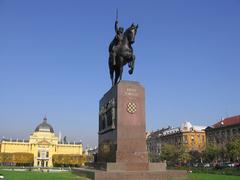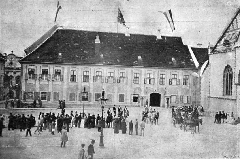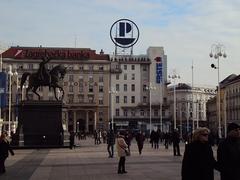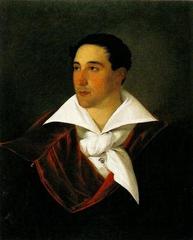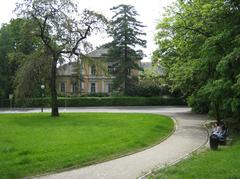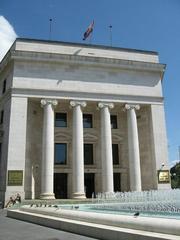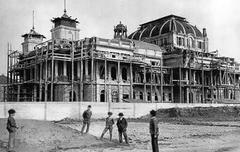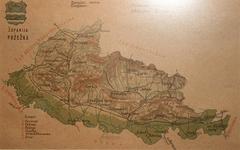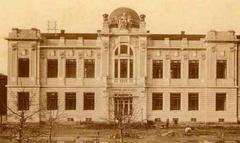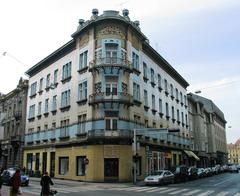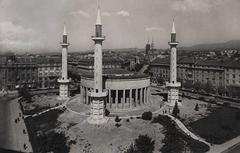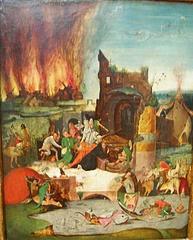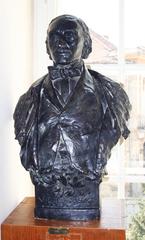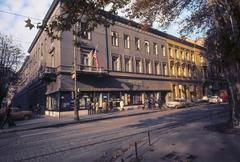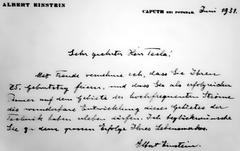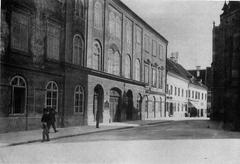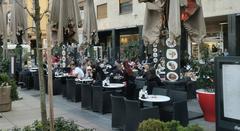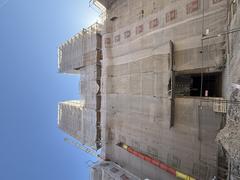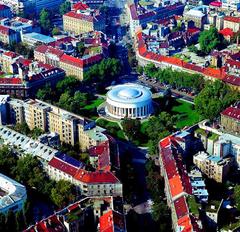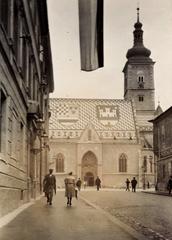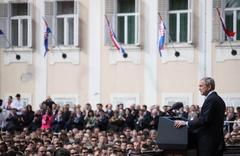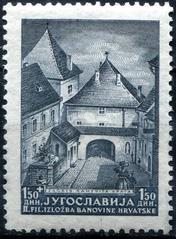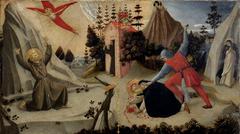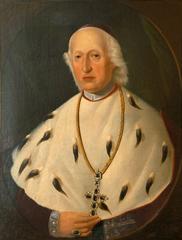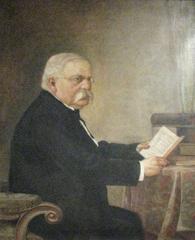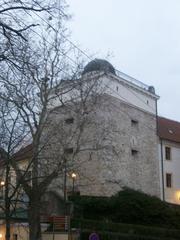Croatian Natural History Museum Zagreb: Visiting Hours, Tickets, and Comprehensive Guide
Date: 14/06/2025
Introduction
Set amidst the cobbled streets of Zagreb’s historic Upper Town, the Croatian Natural History Museum (Hrvatski prirodoslovni muzej) stands as a testament to both Croatia’s scientific achievements and cultural legacy. Housed in the architecturally significant Amadeo Palace—once the city’s first public theater—the museum offers a captivating journey through the country’s geological evolution, diverse ecosystems, and paleontological wonders (ING-GRAD; croatia2go.com).
With over 2 million specimens, including globally renowned Neanderthal fossils from Krapina, the museum is both a research hub and a dynamic educational space. Recent EU-funded renovations have transformed the institution into a modern, accessible destination with interactive exhibits, advanced laboratories, and state-of-the-art facilities (Museum EU Projects; lovezagreb.hr). Its central location also places it within walking distance of key Zagreb landmarks, making it an essential stop for visitors interested in science, culture, and history.
This guide provides detailed information on the museum’s history, collections, visiting hours, tickets, accessibility, exhibitions, and practical tips to ensure you make the most of your visit.
Table of Contents
- Museum History and Cultural Significance
- Institutional Development and Modernization
- Collections and Exhibition Highlights
- Visiting Information
- Visitor Experience and Practical Tips
- Accessibility and Inclusivity
- Nearby Attractions
- Frequently Asked Questions (FAQs)
- Contact Information
- Conclusion and Final Tips
- References
Museum History and Cultural Significance
Founded in the late 19th century and housed in the historic Amadeo Palace, the Croatian Natural History Museum is both a guardian of national heritage and a beacon of scientific advancement. The Amadeo Palace itself is steeped in history, having served as Zagreb’s first public theater from 1797 to 1834 (ING-GRAD). The museum’s establishment reflected a broader European trend of merging scientific research with public education, aiming to preserve and celebrate Croatia’s natural wonders.
Through decades of expansion, the museum has built a reputation as a leader in natural sciences, education, and cultural engagement. Scientific discoveries—such as those from the Krapina Neanderthal site—have placed the institution at the forefront of European research, while its exhibitions and outreach programs continue to inspire visitors of all ages (hpm.hr; wikipedia).
Institutional Development and Modernization
Early Collections and Growth
The museum began with modest collections in geology, paleontology, zoology, and botany, which expanded through fieldwork, donations, and international collaborations. Today, it houses over 2 million specimens, making it the largest institution of its kind in Croatia.
EU-Funded Renovation
A recent, extensive renovation—backed by EU funds and the City of Zagreb—has redefined the museum as a modern, accessible institution. Key improvements include:
- Restoration of Amadeo Palace, preserving historical architecture while meeting contemporary museum standards
- 39 new exhibition halls equipped with interactive and multimedia displays
- Advanced laboratories and conservation facilities
- Improved accessibility features, including ramps, elevators, and accessible restrooms
- Addition of a café and souvenir shop for enhanced visitor comfort (Museum EU Projects; lovezagreb.hr)
Collections and Exhibition Highlights
Main Departments
- Geological and Paleontological Department: Home to over 300,000 specimens, including the world-famous Krapina Neanderthal fossils.
- Mineralogical and Petrographic Department: Features an impressive array of rocks, minerals, and crystal specimens.
- Zoological Department: Houses over 1.1 million animal specimens, with a focus on Croatian biodiversity.
- Botanical Department: Contains approximately 100,000 plant specimens, including a DNA tissue collection vital for research.
Exhibition Highlights
- Krapina Neanderthal Diorama: The centerpiece exhibit, providing insights into prehistoric human life (wikipedia)
- Stone Map of Croatia: The world’s largest geological map made from native rocks
- Interactive Installations: Touchscreens, augmented reality, and multimedia presentations make learning accessible and engaging
- Temporary Exhibitions: Regularly changing thematic displays on natural history and environmental science
- Amadeo Stage: Summer cultural programs featuring theater, music, and film (hpm.hr)
Library and Archives
A scientific library, established in 1868, supports research and public inquiry with rare manuscripts and contemporary literature (hpm.hr).
Visiting Information
Location and Access
Address: Demetrova 1, Upper Town (Gornji Grad), Zagreb
Easily accessible by tram (lines 4, 9, 11, 13), public buses, and a short walk from major city attractions. Parking is limited in Upper Town; use public garages or street parking in Lower Town.
Opening Hours (2025)
- Tuesday – Thursday: 10:00 – 18:00
- Friday – Saturday: 11:00 – 19:00
- Sunday: 10:00 – 14:00
- Closed: Mondays and public holidays
Special closure dates: June 19, June 22, July 1, August 5, August 15
Always check the official museum website for the latest updates.
Tickets and Admission
- Adults: €15
- Students, schoolchildren, seniors (65+): €8
- Family ticket (parents + up to 3 school-age children): €25
- Groups (5–25 people): €10 per person
- Free entry: Children under 7, persons with disabilities, Croatian war veterans (ID required), HMD and ICOM members
Tickets are available at the entrance or online. Group visits, guided tours, and workshops must be booked in advance ([email protected]).
Visitor Experience and Practical Tips
- Allocate 2–3 hours for a comprehensive visit, including interactive zones and temporary exhibitions.
- Photography: Non-flash photography is generally allowed, but always check for restrictions.
- Cloakroom: Secure storage for up to seven days.
- Souvenir Shop: Educational gifts, minerals, and books are available onsite.
- Refreshments: No café in the museum, but many cafés and restaurants are steps away.
- Combine your visit with nearby attractions like St. Mark’s Church, Zagreb City Museum, and Lotrščak Tower.
- Check for restoration updates: Some areas may be temporarily closed due to ongoing renovations (hpm.hr).
Accessibility and Inclusivity
The museum is fully accessible, with ramps, elevators, and adapted restrooms. Free entry is provided for persons with disabilities, and staff are trained to assist visitors with special needs. Key materials are available in Croatian and English.
Nearby Attractions
- St. Mark’s Church
- Stone Gate
- Zagreb City Museum
- Botanical Garden of the Faculty of Science
- Museum of Arts and Crafts
These sites are within walking distance and offer a broader perspective on Zagreb’s rich cultural landscape.
Frequently Asked Questions (FAQs)
Q: What are the Croatian Natural History Museum visiting hours?
A: Tuesday–Thursday 10:00–18:00, Friday–Saturday 11:00–19:00, Sunday 10:00–14:00, closed Mondays and public holidays.
Q: How can I buy tickets?
A: Tickets are available at the entrance and online. Group tours and workshops require advance booking.
Q: Is the museum suitable for children?
A: Yes, with interactive exhibits and family workshops.
Q: Are there any free entry options?
A: Yes, for children under 7, persons with disabilities, Croatian war veterans, and certain members.
Q: Is the museum wheelchair accessible?
A: Yes, all exhibition areas are accessible.
Q: Can I take photos inside?
A: Non-flash photography is permitted in most areas, but check with staff for restrictions.
Contact Information
- Address: Demetrova 1, 10000 Zagreb, Croatia
- Telephone: +385 1 4851 700
- Email: [email protected]
- Website: www.hpm.hr
Conclusion and Final Tips
The Croatian Natural History Museum is a true jewel of Zagreb, offering an enriching blend of science, history, and culture for visitors of all ages. With its world-class collections, engaging exhibitions, and commitment to accessibility, the museum stands as both a scientific institution and a community cornerstone. Plan your visit by checking the latest updates on the official website, and enhance your experience with the Audiala app for interactive tours and insider tips.
Whether you’re a local, a student, or an international traveler, the Croatian Natural History Museum promises an unforgettable exploration of Croatia’s natural and cultural heritage.
References
- This is a sample text. (ING-GRAD)
- This is a sample text. (croatia2go.com)
- This is a sample text. (lovezagreb.hr)
- This is a sample text. (radiozagreb.com)
- This is a sample text. (Museum EU Projects)
- This is a sample text. (wikipedia)

